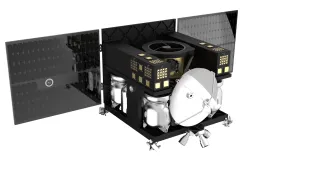
In the European Space Agency's ClearSpace-1 mission, a 'garbage vehicle', will fly into space in 2025 and remove a fragment of an old rocket from orbit. The clearing satellite is being built by the Swiss start-up ClearSpace SA. Polish experts from the Space Research Centre PAS are also involved in the project. “Clearing the orbit is a preventive measure,” says project participant Jędrzej Baran.
Jędrzej Baran is a systems engineer at the Satellite Mechatronics and Robotics Lab of the Space Research Centre of the Polish Academy of Sciences in Warsaw. He specializes in mechatronics, system engineering and project management.
PAP: Why does the orbit need to be cleared? It is a huge space.
Jędrzej Baran: When the first satellite was launched in 1957, the use of space progressed slowly compared to the current rate of increase in the number of satellites, and nobody cared that various unnecessary objects might remain in orbit. According to the laws of physics, without the braking effect of the atmosphere, these objects can orbit the Earth practically endlessly, especially in higher orbits. However, with the development of space technology, the rate of filling the orbit has accelerated significantly. There have even been several serious collisions in space. What's worse, each such collision generates a mass of debris that can hit other orbital objects, and this may even cause a kind of chain reaction. Clearing up the orbit is therefore a preventive measure, aimed at avoiding a situation in which space is so littered with debris that safe use of it is very difficult.
PAP: You are collaborating with the Swiss company ClearSpace on the construction of a space 'garbage truck'. How is it supposed to work?
J.B.: ClearSpace is a start-up created at the Federal University of Technology in Lausanne, which intends to remove a Vega payload adapter (Vespa Upper Part) from orbit in the ClearSpace-1 mission under the supervision of the European Space Agency. It is a cone with a base of about 2 meters and a height of about 1.5 meters. It poses no threat at present, but it is a good target for demonstrating the technology. Each such mission to remove a space object requires, first of all, a proper approach. The chasing satellite called chaser moves closer to the object you want to catch. Then he has to grab it. In the case of the planned mission, the chaser will be equipped with a mechanical gripper consisting of four arms, whose task is to enclose the entire object. Then the chaser's engines will slow down the whole thing, and this will cause it to fall into the atmosphere together with the captured part of the rocket. It will be a kamikaze mission, in which both the target and the space garbage vehicle itself will be destroyed.
PAP: Isn't that a waste? Could such a clearing satellite not remove a lot of debris by changing its orbit?
J.B.: Various approaches have been analysed. Each change of orbit - to a lower or higher one - requires a large amount of fuel. You have to use the engines to accelerate or decelerate. It turns out that it is more viable to send disposable clearing satellites to specific objects than to carry fuel to change orbits into space. Perhaps in the future this will change as a result of technological development, but this is the situation today.
PAP: Will the clearing satellite have to be specially adapted to each target, for example in terms of the shape or size of the gripper?
J.B.: The satellite is supposed to be able to catch any object that fits inside the grapple element. So it is largely universal. As I mentioned, this is a demonstration mission, but ClearSpace plans to provide satellite deorbitation service as part of its commercial activity. I suspect that in the plans for this further, business stage of the developed technology, ClearSpace will create a series of types of several different sizes for several classes of objects. The company intends to offer commercial services for the removal of various types of space debris.
PAP: In what orbits will the ClearSpace satellite be able to operate?
J.B.: There are no limits in this respect. The satellite will be able to operate in different orbits.
PAP: Which part of the mission are you working on?
J.B.: We are involved in earth tests of the technology designed by the Swiss. Space conditions cannot be fully reproduced on Earth, at least not all of them simultaneously. Therefore, partial tests are carried out to check the behaviour of the device under the influence of a specific aspect of the space environment - for example, in a thermal-vacuum chamber, or in free fall conditions. At the Satellite Mechatronics and Robotics Lab of the Space Research Centre PAS, we have been developing the technology of testing robotic systems in simulated microgravity for many years.
PAP: How can it be done?
J.B.: As we know, objects in space move in a state of weightlessness, so the weight of the designed structures is less important than on Earth. Orbital elements can therefore be much lighter, filigree, while on Earth most such space structures could collapse under their own weight. To recreate microgravity, we use a special device that we call a granite table. It is an object with a very flat and precisely measured surface, on which we can carry out tests using the so-called air bearings. These are small air cushions that hold the tested structure.
By using air cushions, we practically eliminate the effect of friction - the tested element moves completely freely, i.e. as if not affected by Earth's gravity. Therefore, for the purposes of our experiments, we can assume that it moves in weightlessness - just like in outer space.
We created accurate, scaled-down models of the catcher satellite and the target satellite and tested them on a granite table.
As part of our involvement in the mission, we had to design the entire rescaled systems of both satellites - the catcher and the target - to fit entirely on our granite table. Thanks to this, we were able to use special steerable platforms to carry out interception manoeuvres, which will ultimately be performed in orbit during the target mission.
PAP: What was the most difficult part?
J.B.: When the size of the model decreases, everything changes. For example, reducing length by a factor causes areas to decrease by the square of that factor and volumes by its cube. However, the situation is even more complicated. If an element becomes, for example, three times shorter, it does not mean that it is three times less susceptible to some forces. In this case, scaling is less obvious. Therefore, in order to effectively analyse the behaviour of our scaled-down system, we had to perform complex calculations and analyses to be able to correctly interpret the experimental data obtained from our tests on the granite table.
PAP: What are you doing now?
J.B.: We have successfully completed our original task in the project. The system we were involved in was just one of many that ClearSpace had to design to get ESA's approval at this stage of the mission. Approx. two weeks ago, ClearSpace obtained ESA's approval of the project deliverables from all contractors. This approval is a green light for further design work.
Now we are waiting for the next tasks to start. In fact, in space projects, the scope of work is constantly evolving, so we expect that, despite the established scope of the project, they will be precisely defined soon. They will certainly concern further research using the system we have designed with some changes. It is also possible that we will prepare additional devices that will enable testing the efficiency of the full scale gripping system, but at the moment we do not have specific information on this subject.
PAP: When is the satellite expected to fly into space?
J.B.: The demonstration mission is scheduled for 2025. The company had a delay of about six months, but this is completely normal in the case of space projects. I do not know if the launch date has been moved, so we stick to the officially announced schedule.
PAP: Let's assume that the demo mission is successful. What determines whether a satellite will start clearing Eart's orbit regularly?
J.B.: The mere approval of the mission by ESA requires the fulfilment of a lot of qualitative criteria and technical requirements. The device is expected to function even if its various systems fail, even if it is partially out of control. For example, in this mission, a faulty approach to the target could result in a collision and an additional increase in the number of debris. There are also many formal matters. The whole mission, however, is incredibly exciting, also because ESA, in its competition for deorbitation, has chosen ClearSpace, a relatively small start-up at the time, and not one of the large European space sector companies.
PAP: So when can ClearSpace 'garbage trucks' start cleaning?
J.B.: Much depends on the priorities of various organizations, such as the European Commission or ESA. I can say unofficially that there is a kind of fashion for clearing the orbit. There are many companies that deal with this topic. Space agencies are interested in it. Moreover, ClearSpace-1 is an ADRIOS mission. The first part of the abbreviation means Active Debris Removal, and the second - In Orbit Servicing. The resulting technology may therefore have more applications than just bringing unwanted objects down from orbit. Perhaps it will be possible to use it, for example, to refuel satellites, or even perform robotic repairs. I think that in this decade we will see an increase in the activity of all major players in this area.
PAP: What about further orbital clutter? After all, the rate at which it is filling up continues to grow.
J.B.: Active removal of satellites from orbit is only one part of solving problems, important especially where other solutions are impossible. Ultimately, space agencies and government entities strive to account for a controlled end at the design stage of new missions. The current recommendations are that up to 25 years after the planned end of a satellite's mission, it should either - if it is in lower orbits - perform a controlled deorbitation (using its own engines) or move to the so-called graveyard orbit. The goal is to prevent the formation of new space debris. This is related to the so-called Clean Space. (PAP)
PAP - Science in Poland, Marek Matacz
mat/ agt/ kap/
tr. RL













